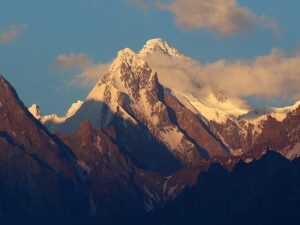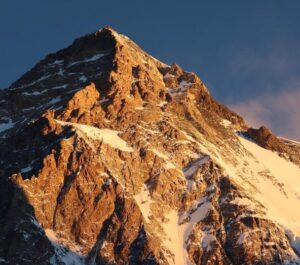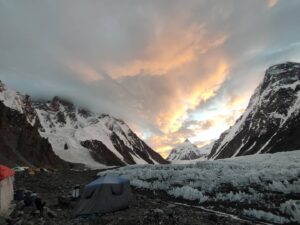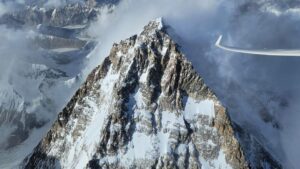This past summer, Afghan climber Ali Akbar Sakhi died just below Camp 3 on K2. It was initially reported that he died on July 21 of a heart attack. However, his body told a different story. A doctor who reached Sakhi shortly after the climber collapsed noted stiff muscles and cyanotic, bluish cheeks. The doctor concluded that Sakhi had been in the open for a long time. In a cruel twist of fate, that doctor, Canadian Richard Cartier, also died on K2.
An email from the dead
After news of the accident broke, there were rumors about the circumstances surrounding Sakhi’s death. Yet no one wanted to speak on the record. As with other mountain controversies, climbers try to avoid publicly criticizing anyone whom they might meet on future expeditions. They also worry about being branded as envious or biased. “The 8,000’er industry behaves like the Mafia,” an ExplorersWeb source vented.
But then, three weeks ago, we got an email from the dead.
Using Ali Akbar Sakhi’s old email address, his widow, Karima Sakhi, reached out. “I really want the world to know what happen to him and how he died. He was left alone only 150m below Camp 3. No one helped him. No one went to look for him for 12 hours,” she wrote.
As far as we know, this is what happened.
A frenzy of activity on K2
On July 20, 2022, K2’s Abruzzi Spur route bustled with activity. The Shoulder, where Camp 3 sits, was especially busy. Despite high winds and bad weather, the forecast suggested the weather would soon improve. A group of Sherpas was on their way to the summit, and hundreds of climbers were on the move toward Camps 3 and 4. They hoped to follow in better weather the following day.
Sakhi climbed with Karakorum Expeditions (KE), a Pakistani company led by Mirza Ali. He had paid (according to Sakhi’s wife) around $40,000, which included three bottles of oxygen for the summit push and the services of a guide/porter.
According to Karakorum Expeditions, Sakhi was supported by Dhaulat Muhammad, whom they identify as his guide. Sakhi had previous experience at altitude. He had previously climbed Noshak (Afghanistan’s highest peak) and some mountains in the Hindu Kush. Yet he specified to the agency that he needed an “experienced Sherpa” all the way to the summit on the expedition membership application form, provided to ExplorersWeb by Karakorum Expeditions.
Between Camp 2 and Camp 3
On the morning of July 20, Sakhi sent a voice message to his wife before leaving Camp 2. He told her that he was “feeling great”. But something went wrong on the way to Camp 3.
In a video recorded by Sakhi on his cellphone at 10:35 am, he says, “We are above Camp 2 and my climbing mate’s down suit has torn, we are waiting for him.” Karima Sakhi helped us with the translation from Dari, a Persian dialect spoken in Afghanistan.
At 8:30 pm, Sakhi and his high-altitude porter (HAP) were still ascending. In a second video recovered from his phone, Sakhi says, “Climbing K2 is not easy, and I am with a porter who has never been here. That’s why he didn’t know the exact timing and we got stuck in a storm. [We are] trying hard to get out of the situation. God help us.”
Eventually, Sakhi stopped and could not move. The HAP continued on his own toward Camp 3, leaving his client in the snow.
“I was told it was Ali who told the porter to go ahead but I can’t believe it. If he did, why did no one go back to help him when he didn’t show up?” Karima Sakhi asked.
Unanswered questions
In Karakorum Expeditions’ official report into Ali Akbar Sakhi’s death, they offer their side of the story. Their report states that Sakhi had been slow during his rotations and had been coughing from the start of the expedition. Yet he insisted on participating in the summit push.
He was accompanied by guide Dhaulat Muhammad. The report notes Sakhi was also very slow after departing Camp 2 but insisted on proceeding despite Muhammad’s suggestion that they retreat to Camp 2. The report then states:
The weather turned extremely bad and night was approaching. As they were at approximately 7,050m, it was already dark and an extreme blizzard started raging on the mountain. Ali [Sakhi] was very slow and couldn’t move. He was not willing to go down, either. At one point, his movement stopped, the storm and blizzard made everything worse. Ali was so tired that he could neither climb up or climb down.
Ali and his guide sat on the wall…as the blizzard was hitting them hard. He was developing high altitude sickness as there was a pre-existing illness of cough [sic]. On the mountain, coughing is normal because of the dry air, but Ali’s prolonged cough might have been of a different nature. For the first time, Ali mentioned to his guide that he had heart issues while they were stuck on the wall.
[Their] health and the weather was getting worse and Ali’s guide headed to Camp 3 to get support. Ali’s guide climbed to Camp 3 in extremely bad weather.
*Please note that the report has been lightly edited for clarity.
Why did no one go down to help?
The report leaves some unanswered questions about Sakhi’s condition and the guide’s skills. But most importantly, it fails to address why, with a large support team in Camp 3, no one went down to help Sakhi. Instead, Sakhi was left in the open for an entire night.
At Camp 3, Karakorum Expeditions had a big team. There was a large group of porters to assist Samina Baig on her way to the summit. The sister of Karakorum Expedition’s owner Mirza Ali, this was Baig’s third attempt on K2. She was determined to become the first Pakistani woman to summit K2.
The night in Camp 3
That evening, everyone on the team knew that Sakhi had not made it to Camp 3. Team member Michael Pfeiffer of Denmark noted on Facebook: “The last climber never reached Camp 3. The weather conditions made it impossible to complete a proper search, so we spent the night huddled in overcrowded tents, with little sleep and extreme winds outside.” You can read the entire report here.
Other climbers confirmed that Sakhi never made it to Camp 3. “I arrived at Camp 3 on July 20 and Mirza Ali’s team was there, but Ali [Sakhi] was not with them and we didn’t know about [what happened to] him until we came down from the summit two days later,” a climber who preferred to remain anonymous told ExplorersWeb.
Weather timeline
The same climber confirmed that the weather had worsened as they were approaching Camp 3 on July 20, getting very cold and windy. “It was still very windy when I got to sleep at around 8:30 pm. The following morning and the next day were perfect, with sun and little wind.”
It is not clear when the wind abated, but according to some climbers, the storm didn’t last all night. Naila Kiani of Pakistan, who summited on July 22 with Sirbaz Khan, was in Camp 2 on July 20. She was constantly checking the weather with meteorologists in Islamabad. The meteorologists reported that the winds had abated at the altitude of Camp 3 by 10:30 pm that night.

The view from K2 at 5:26 am on July 21 showed beautiful weather. Photo: Naila Kiani
Stefi Troguet of Andorra also confirmed to ExplorersWeb that the wind started around noon on July 20. She recalls that she considered it windy, with some strong gusts, but not a blizzard. Soon after reaching Camp 3 in the afternoon, she went to sleep, so she doesn’t know when the wind abated. She confirmed that the following morning dawned with excellent weather.

Camp 3 on the morning of July 21. Photo: Stefi Troguet
The morning of July 21
On the morning of July 21, while most of the Karakorum Expeditions team resumed their climb, two porters descended from Camp 3. But they were not going to look for Sakhi. They were accompanying Michael Pfeiffer, who had decided not to continue with his summit push. Here is Pfeiffer’s account of what happened during their descent.
In the morning, together with two HAPs, one a strong climber but with signs of altitude sickness, I started to descend. Within a short time we found our last climber, huddled in the snow but still alive despite spending the night out at about 7,150m, exposed to extreme weather. Due to the landscape and the weather conditions, he had no idea Camp 3 was close.
We quickly gave him oxygen and he seemed in not so bad shape. My main concern was getting him down the Black Pyramid and he assured me he could [do it]. I doubted it. I went ahead to see if any more help was to be found. Shortly after, he collapsed and died of heart failure. Nothing was to be done.
“We did not know how far he was,” Pfeiffer told ExplorersWeb. “The weather conditions were extreme and it was pitch black. Sending anyone out in those conditions would undeniably put their lives at risk.”
According to Sakhi’s widow, Pfeiffer left Camp 3 at around 9 am and found Sakhi at 9:30 am.
The outfitter’s report
The Karakorum Expeditions report reads as follows:
Arshad the most senior guide and Daulat descended to Ali’s support, the other Shimshalis arrived 10 minutes ahead and gave Ali water, cheese. He drank water and ate cheese and chocolate, he again mentioned to them as well that he has heart issues. When Michael inquired whether he would make it through black pyramid, he replied, Yes he can.
Michael continued the descent, while Arshad and Daulat had already put Ali on artificial Oxygen and tried to climb down. Ali hardly moved and repeatedly mentioned he had heart issues. After a few meters climbing down, at approx 7000m, Ali collapsed on the rope. Arshad tried to put him back to his feet, he was unresponsive. At that moment Sirbaz Khan, Pakistani renowned climber, with his two companions arrived at the spot.
To summarize, on July 20, Sakhi managed to overcome the steep passages of the Black Pyramid and arrived in a less steep area of soft snow above. As Pfeiffer confirms, he was very close to Camp 3, where there were supplies, O2, and drugs such as dexamethasone that could have helped him survive. During a full summit push, Camp 3 was crowded with well-supplied commercial teams. The entire Abruzzi Spur route was fixed, so there was no risk of getting lost, even in darkness and bad weather.
Other climbers continue up
Meanwhile, Samina Baig and most of the Karakorum Expeditions team proceeded to Camp 4. Then, on the morning of July 22, Baig reached the summit (along with some 145 other climbers that day). Baig was supported by six high-altitude porters: Eid Muhammad, Bulbul Kari, Ahmed Baig, Rizwan Dad, Waqar Ali, and Akber Hussain Sadpara. On their way down to Base Camp, they all passed the body of Ali Akbar Sakhi.
“His body was near the fixed ropes, everyone descending from Camp 3 saw him,” another K2 climber admitted.
The Pakistani team
Naila Kiani was on K2 for the first time, after summiting her first 8,000’er, Gasherbrum 2, in 2021. Her climbing teacher and mentor, Ali Raza, who was supposed to guide her on K2, had died in a rock climbing accident just weeks before. Shocked, Kiani instead climbed with Sirbaz Khan. Khan, currently focused on completing the 14×8,000’ers, initially had no plans for K2 that year. But he decided to go as a tribute to Raza, who had also mentored him.
On July 21, they were on their way to Camp 3 with a large group of climbers when they saw Sakhi lying on the snow.

A frame of a video shot by Naila Kiani as she climbed toward Camp 3. She saw that something was wrong on the route ahead. Sirbaz Khan stopped to help a climber in trouble. Photo: Naila Kiani
“Ali Akbar Sakhi collapsed right in front of Sirbaz Khan, who was climbing some 30 minutes ahead of me,” she told us. “As I approached, I zoomed in with the phone video, trying to see what was going on. I saw a little Afghani flag falling toward me; I grabbed it, and then I knew it was Ali Akbar.”
Kiani recorded the video at 11 am, so she estimates that Khan probably met Sakhi around 10:30 am. He was at approximately 7,100m.
According to Michael Pfeiffer’s report, they had found him 50 vertical metres higher, so Sakhi had managed to walk down another 50m before collapsing.

Arshad (left) and Sirbaz Khan (right) perform the last rites for perished climber Ali Akbar Sakhi. They prayed, closed his eyes, put the Afghani flag inside his jacket, and covered his face with his down suit hood. They then led the task of moving his body down. Frame from a video not published out of respect for Sakhi.
Last rites
“When I got there, I got very emotional,” Kiani admits. “I wanted to perform CPR on him, hoping he was still alive.” But Kiani’s climbing group included Dr. Richard Cartier. He checked Sakhi and confirmed that there was nothing to be done.
According to Kiani, Sirbaz Khan and Arshad performed the last rites (prayed, closed his eyes, and covered his head with his downsuit’s hood) and took charge of moving the body down the mountain as the two porters who had come down from Camp 3 were overwhelmed.
“Sirbaz moved Ali Akbar [Sakhi] down for over two hours to 7,000m and secured his body to a rock,” Kiani said.
Kiani and Khan later moved on and summited Gasherbrum I. Yet Kiani has not been able to forget the traumatic experience on K2. She has posted a sobering report on her Instagram, including her team’s role in helping to move Ali Akbar Sakhi’s body from the route.
Ali Akbar Sakhi was trying to become the first Afghan climber to summit an 8,000’er. He was also trying to promote Afghanistan’s Hindu Kush mountains. As a successful entrepreneur and IT consultant, he was actively involved in charity work.
He was a friendly guy, popular in Base Camp. “Basically, everybody liked him,” a climber told us.

Ali Akbar Sakhi at home in Afghanistan. Photo: Ali Akbar Sakhi
Ego vs lives
Luis Miguel Soriano of Spain, who was on K2 climbing and filming the ascent of cancer survivor Rosa Fernandez, talked frequently with Sakhi, thanks to Soriano’s knowledge of Persian. “He was so friendly,” Soriano said. “We talked and made plans to climb together in the mountains of Panshir, in Afghanistan.”
Sakhi’s last post on Instagram, some days before his summit push, showed a group of climbers celebrating Eid — the Muslim festival ending Ramadan — in Base Camp. “Everyone is here for the dream they always run for…I hope that every one of us will safely climb K2 this year,” he wrote.
Luis Espinoza of Mexico was in Base Camp when Sakhi died. Later, he wrote that people are only focused on their social media accounts and on promoting their egos.
“Ego and selfishness are more important than other people’s lives,” he wrote. “They do not help with accidents, they see the problem and leave, or look to the other side and continue descending. They do not care if those in trouble have a family or children.”
Karima Hurmat Sakhi, Ali’s widow, is currently fighting for a new life in the U.S., far from bitter conversations with Karakorum Expeditions. She is raising her three little children, aged eight, five, and two.
Karakorum Expeditions insists that Sakhi did not pay the complete fee for the K2 expedition. The Sakhi family claims that he had the money when he traveled to Skardu by car, all of it in cash since there are strict limits to withdrawing money from Afghan banks.

Ali Akbar Sakhi’s widow, Karima Sakhi. Photo: Anthrowcircus.com
The aftermath: Karima Sakhi
Karima Sakhi was further upset by how she was told of her husband’s death. “They asked me if I wanted my husband’s body back, and I said yes, but then they called again and said the body could not be retrieved,” she said.
Indeed, rescuing a body from 7,000m on K2 is an extremely difficult task. Clearly, she should not have been given the option in the first place.
“All I could think of is that my husband deserved a grave and he couldn’t have it,” she told ExplorersWeb in tears. “My [eight-year-old] boy used to send messages to his daddy on WhatsApp, saying ‘Daddy I want to bring your body back,’ every single day”.
Karima Sakhi does not accept the official cause of death as the result of AMS and a heart attack. Instead, she points to hypothermia, exhaustion, and neglect. She has asked Pakistan’s mountain-related authorities to investigate.
“To all the mountaineers out there, please choose the best for yourself, you deserve to live a long life. It is true that anything can happen in the mountains, but the company and the guide you choose really matter,” she added.
“I have three small boys who don’t even understand the loss they’ve suffered. They should know that their daddy was a fighter who didn’t easily give up.”
Karima Sakhi plans to publish more of her side of the story soon. In the meantime, you can read more about her life as one of the few Afghan women who get to marry for love and by choice in this article on Anthrowcircus.com.






